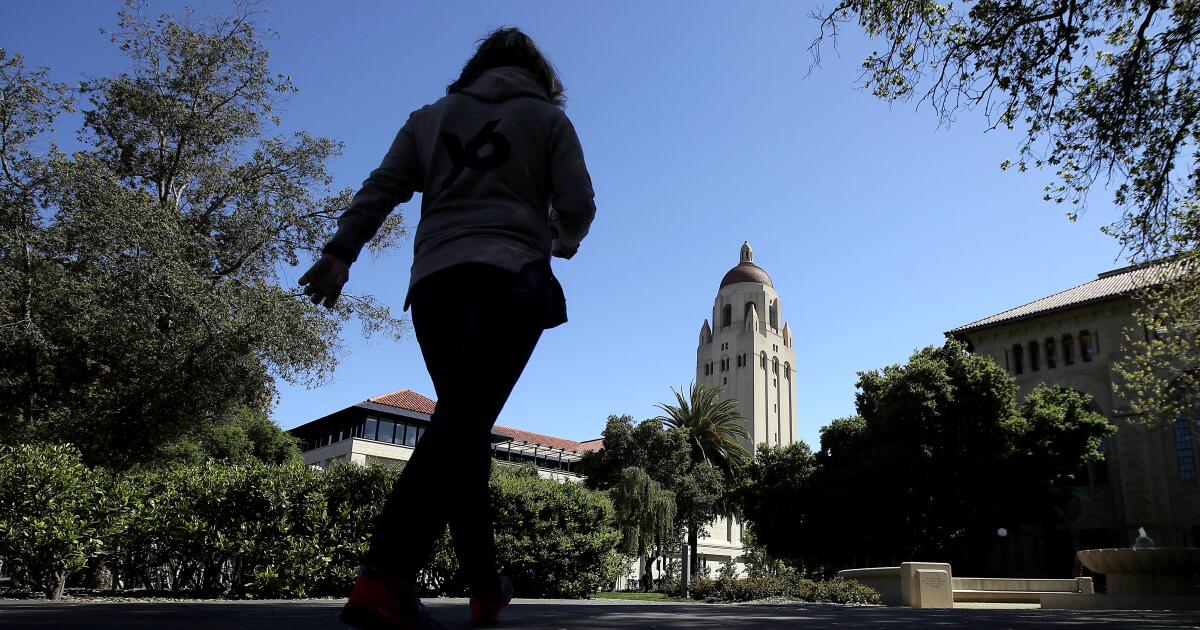Business
Column: Elon Musk's dumbest idea is to send human colonists to Mars

The image of Elon Musk that may be dominating people’s mindspace at the moment is of his prancing about joyously — and, yes, a tad weirdly — behind Donald Trump on the podium during the latter’s Oct. 5 rally in Butler, Pa.
But how many people noticed the clue to Musk’s worldview on display at the event? For visible under his jacket was a T-shirt bearing the legend, “Occupy Mars.”
That’s a pointer to one of Musk’s most dearly held goals, which is to populate Mars with humans, transported to the Red Planet presumably by Musk’s rocketship company SpaceX. Musk has been airing this idea for years, even a decade or more. His mantra, as he tweeted as recently as a few weeks ago, is that “becoming multiplanetary is critical to ensuring the long-term survival of humanity and all life as we know it.”
Outer space seems designed to kill us.
— Scientific American
Musk brings up the idea of colonizing Mars so often that it can properly be regarded as a whim of iron. It’s a whim because he plainly hasn’t pondered soberly the obstacles in the way.
The technical challenges of sending a spacecraft to Mars, the distance to which from Earth averages about 140 million miles, are plainly the least difficult, since we’ve already done it: NASA landed the robotic rovers Spirit and Opportunity on Mars in January 2004.
Spirit functioned for five years, sending telemetry back to Earth from its five-mile range; Opportunity ranged over 28 miles of the Martian landscape for an amazing 15 years (its fascinating and endearing life story is told by “Good Night Oppy,” a documentary streaming on Amazon Prime).
All the other challenges are harder, and many are not amenable to human ingenuity at this stage. They’re financial, biological and psychological — and also technical, when the question is not how to get to Mars but how humans can function and survive once we’re there, much less establish a permanent presence.
Musk’s timeline for colonizing Mars has shifted constantly since he began bringing it up. Last month he announced that the first Mars-bound Starships would launch (unmanned) in two years, when Mars and Earth come to their nearest approach, as they do every 26 months or so.
If the landings succeed, the first crewed missions would take place two years later. Further flights, he said, would fulfill the goal of building a “self-sustaining city in about 20 years.”
Yet he also has talked about sending 1 million human colonists for that self-sustaining city in Mars by 2050, a mere 24 years after the first manned touchdown. In 2020 he posited building a fleet of 100 Starships every year for 10 years, parking them and their passengers in Earth orbit to await the next Earth-Mars near approach.
Such pronouncements have often elicited credulous reactions from Musk’s interviewers. They should know by now, however, that taking them at face value is the wrong way to bet.
Musk is notorious for the unreliability of his timing and engineering forecasts. While his words are taken as gospel by his fan base, many in the automotive and high-tech communities have learned from bitter experience not to trust them. It’s proper to ask whether he has ever met a self-imposed deadline for bringing out a new product or feature or fulfilled his claims for their capabilities.
The freshest example was his Oct. 10 unveiling of prototypical self-driving taxis and vans amid claims that his EV company Tesla would have fully autonomous vehicles on the road next year. Tesla shares fell nearly 9% the next day, thanks to world-weary investors who had heard such overcooked claims from him before. (A prototype humanoid robot introduced at the same event and implied to operate autonomously was later revealed to be human-assisted.)
If Musk can’t meet deadlines a few years off, then, why would anyone buy projections dated a quarter-century into the future?
Fancies about interplanetary travel may have their sedulous followers, but skepticism about Musk’s Martian fantasy have been mounting. Last month, the Wall Street Journal did the math on the 26-month cycle in which the Earth and Mars approach each other close enough to make travel between them practical, and reported that Musk’s timeline for Mars settlement was unlikely within his lifetime. (He’s 53.)
As for the other obstacles, they’re legion. One is the question of who would pay for the project. As rich as he is — he is often described as the richest or second-richest person on Earth, with a fortune estimated at $195 billion — he doesn’t have the resources to go it alone.
Indeed, without its billions of dollars in U.S. government contracts, SpaceX would be going nowhere fast, even in Earth orbit. But whether the U.S. would have the political will or fiscal capacity to mount a project estimated to cost $1 quadrillion (that’s 1,000 trillions) is doubtful in the extreme even if spread out over several decades.
Space aficionados often compare the drive to explore other worlds to the impulse that sent humans on voyages around the world, depicting our forebears’ curiosity about our own planet as an innate curiosity that defines us as an alpha species. It’s comforting to think of ourselves that way, but more than a little pompous.
The truth is that the chief impulse that sent Europeans around the world was commercial. The Spanish came to the New World in search of gold, Russians for pelts, others for spices, raw materials, fishing grounds, etc., etc. They spent fortunes in these efforts, but they were willing to invest on the expectation of a healthy financial return.
Human interplanetary exploration will be more dangerous and more costly, especially if robots can do the work, and the lack of a discernible economic return a greater obstacle. “We haven’t even colonized the Sahara Desert, the bottom of the oceans or the moon, because it makes no economic sense,” the physician Danielle Teller observed nearly a decade ago. “It would be far, far easier and cheaper to ‘terraform’ the deserts on our own planet than to terraform Mars. Yet we can’t afford it.”
NASA estimates the length of a voyage to Mars as at least nine months, during which the passengers would be bombarded by radiation and their bodies warped by weightlessness and by Martian gravity, which is 38% that of Earth. It may not be a survivable journey.
“Outer space seems designed to kill us,” Scientific American observed last year. “Humans evolved for and adapted to conditions on Earth. Move us off our planet, and we start to fail — physically and psychologically. The cancer risk from cosmic rays and the problems that human bodies experience in microgravity could be deal-breakers.”
Astronauts on the International Space Station, where the stays have typically been six months or less (a few record breakers have approached or exceeded one year), were known to have experienced weightlessness-associated visual impairments due to changes in the eye that were “not fully reversible upon return to Earth,” according to a 2018 study.
What would the colonists find upon arrival?
They would encounter a barren landscape without water or breathable atmosphere, bathed in deadly solar and galactic radiation from which Earthbound humans are protected by our planet’s atmosphere and magnetic field. Food, water and other resources would have to be shipped from home, at distances that make the supply frighteningly undependable. They would have to live underground, adding to psychological disorientation compounded by their sheer remoteness; they would be the first humans who were living beyond a view of Earth itself.
Mars is more inhospitable to human occupation than the most punishing terrestrial environments, such as Antarctica and the remote desert. Its average surface temperature is minus 85 degrees, and can fall as low as minus 225 degrees.
Then there are the psychological pressures of underground life hopelessly far from home. An oft-mentioned cautionary tale is the experience of Biosphere 2, in which eight volunteers — four men and four women — were sealed in a futuristic glass structure in Arizona from 1991 to 1993 as an experiment in remote self-sustained living.
They raised crops and domestic animals for food and enjoyed their lifestyle, until “the human element” intervened, as one of the subjects wrote later. “We contracted a syndrome psychologists call irrational antagonism. That is, we split into two groups of four. A power struggle over the project’s direction made things much worse.” Their oxygen supply dwindled, producing a syndrome resembling altitude sickness, due to a miscalculation about photosynthesis.
They had encountered an age-old phenomenon common in insular communities cut off from home. The leader of the 19th century California utopian community Kaweah put it into words: His people “divided into factions, and fractions of factions,” he wrote. “Otherwise good people seem to take a delight in finding flaws in their neighbors.”
It may be that technological advances will eventually overcome these obstacles. But it’s also true that human ingenuity already has produced a solution to some of the most pressing: robots. For what Spirit and Opportunity proved is that there’s little of value that humans can do in deep space that robots can’t do as well, or better.
The ultimate question about Musk’s project is why? His vision seems to have been formed at the age when adolescents become enthralled by science fiction movies set in faraway galaxies — which isn’t to say that they can remain entertaining for adults, too.
But for him, reality is a distraction. For less than the stupendous cost of colonizing Mars, humanity could address the issues that Musk feels will make the Earth uninhabitable, such as global warming. Leaving an Earth warmer by 2 degrees centigrade for Mars “would be like leaving a messy room so you can live in a toxic waste dump,” Kelly and Zach Weinersmith wrote in their 2023 book, “A City on Mars: Can We Settle Space, Should We Settle Space, and Have We Really Thought This Through?”
Good question. Musk plainly hasn’t thought it through, at least not enough to avoid dismissing the challenges with hand-waving. But we can. Our imperative is to fix the home we live in before setting forth to ruin another one.

Business
U.S. Space Force awards $1.6 billion in contracts to South Bay satellite builders

The U.S. Space Force announced Friday it has awarded satellite contracts with a combined value of about $1.6 billion to Rocket Lab in Long Beach and to the Redondo Beach Space Park campus of Northrop Grumman.
The contracts by the Space Development Agency will fund the construction by each company of 18 satellites for a network in development that will provide warning of advanced threats such as hypersonic missiles.
Northrop Grumman has been awarded contracts for prior phases of the Proliferated Warfighter Space Architecture, a planned network of missile defense and communications satellites in low Earth orbit.
The contract announced Friday is valued at $764 million, and the company is now set to deliver a total of 150 satellites for the network.
The $805-million contract awarded to Rocket Lab is its largest to date. It had previously been awarded a $515 million contract to deliver 18 communications satellites for the network.
Founded in 2006 in New Zealand, the company builds satellites and provides small-satellite launch services for commercial and government customers with its Electron rocket. It moved to Long Beach in 2020 from Huntington Beach and is developing a larger rocket.
“This is more than just a contract. It’s a resounding affirmation of our evolution from simply a trusted launch provider to a leading vertically integrated space prime contractor,” said Rocket Labs founder and chief executive Peter Beck in online remarks.
The company said it could eventually earn up to $1 billion due to the contract by supplying components to other builders of the satellite network.
Also awarded contracts announced Friday were a Lockheed Martin group in Sunnyvalle, Calif., and L3Harris Technologies of Fort Wayne, Ind. Those contracts for 36 satellites were valued at nearly $2 billion.
Gurpartap “GP” Sandhoo, acting director of the Space Development Agency, said the contracts awarded “will achieve near-continuous global coverage for missile warning and tracking” in addition to other capabilities.
Northrop Grumman said the missiles are being built to respond to the rise of hypersonic missiles, which maneuver in flight and require infrared tracking and speedy data transmission to protect U.S. troops.
Beck said that the contracts reflects Rocket Labs growth into an “industry disruptor” and growing space prime contractor.
Business
California-based company recalls thousands of cases of salad dressing over ‘foreign objects’

A California food manufacturer is recalling thousands of cases of salad dressing distributed to major retailers over potential contamination from “foreign objects.”
The company, Irvine-based Ventura Foods, recalled 3,556 cases of the dressing that could be contaminated by “black plastic planting material” in the granulated onion used, according to an alert issued by the U.S. Food and Drug Administration.
Ventura Foods voluntarily initiated the recall of the product, which was sold at Costco, Publix and several other retailers across 27 states, according to the FDA.
None of the 42 locations where the product was sold were in California.
Ventura Foods said it issued the recall after one of its ingredient suppliers recalled a batch of onion granules that the company had used n some of its dressings.
“Upon receiving notice of the supplier’s recall, we acted with urgency to remove all potentially impacted product from the marketplace. This includes urging our customers, their distributors and retailers to review their inventory, segregate and stop the further sale and distribution of any products subject to the recall,” said company spokesperson Eniko Bolivar-Murphy in an emailed statement. “The safety of our products is and will always be our top priority.”
The FDA issued its initial recall alert in early November. Costco also alerted customers at that time, noting that customers could return the products to stores for a full refund. The affected products had sell-by dates between Oct. 17 and Nov. 9.
The company recalled the following types of salad dressing:
- Creamy Poblano Avocado Ranch Dressing and Dip
- Ventura Caesar Dressing
- Pepper Mill Regal Caesar Dressing
- Pepper Mill Creamy Caesar Dressing
- Caesar Dressing served at Costco Service Deli
- Caesar Dressing served at Costco Food Court
- Hidden Valley, Buttermilk Ranch
Business
They graduated from Stanford. Due to AI, they can’t find a job

A Stanford software engineering degree used to be a golden ticket. Artificial intelligence has devalued it to bronze, recent graduates say.
The elite students are shocked by the lack of job offers as they finish studies at what is often ranked as the top university in America.
When they were freshmen, ChatGPT hadn’t yet been released upon the world. Today, AI can code better than most humans.
Top tech companies just don’t need as many fresh graduates.
“Stanford computer science graduates are struggling to find entry-level jobs” with the most prominent tech brands, said Jan Liphardt, associate professor of bioengineering at Stanford University. “I think that’s crazy.”
While the rapidly advancing coding capabilities of generative AI have made experienced engineers more productive, they have also hobbled the job prospects of early-career software engineers.
Stanford students describe a suddenly skewed job market, where just a small slice of graduates — those considered “cracked engineers” who already have thick resumes building products and doing research — are getting the few good jobs, leaving everyone else to fight for scraps.
“There’s definitely a very dreary mood on campus,” said a recent computer science graduate who asked not to be named so they could speak freely. “People [who are] job hunting are very stressed out, and it’s very hard for them to actually secure jobs.”
The shake-up is being felt across California colleges, including UC Berkeley, USC and others. The job search has been even tougher for those with less prestigious degrees.
Eylul Akgul graduated last year with a degree in computer science from Loyola Marymount University. She wasn’t getting offers, so she went home to Turkey and got some experience at a startup. In May, she returned to the U.S., and still, she was “ghosted” by hundreds of employers.
“The industry for programmers is getting very oversaturated,” Akgul said.
The engineers’ most significant competitor is getting stronger by the day. When ChatGPT launched in 2022, it could only code for 30 seconds at a time. Today’s AI agents can code for hours, and do basic programming faster with fewer mistakes.
Data suggests that even though AI startups like OpenAI and Anthropic are hiring many people, it is not offsetting the decline in hiring elsewhere. Employment for specific groups, such as early-career software developers between the ages of 22 and 25 has declined by nearly 20% from its peak in late 2022, according to a Stanford study.
It wasn’t just software engineers, but also customer service and accounting jobs that were highly exposed to competition from AI. The Stanford study estimated that entry-level hiring for AI-exposed jobs declined 13% relative to less-exposed jobs such as nursing.
In the Los Angeles region, another study estimated that close to 200,000 jobs are exposed. Around 40% of tasks done by call center workers, editors and personal finance experts could be automated and done by AI, according to an AI Exposure Index curated by resume builder MyPerfectResume.
Many tech startups and titans have not been shy about broadcasting that they are cutting back on hiring plans as AI allows them to do more programming with fewer people.
Anthropic Chief Executive Dario Amodei said that 70% to 90% of the code for some products at his company is written by his company’s AI, called Claude. In May, he predicted that AI’s capabilities will increase until close to 50% of all entry-level white-collar jobs might be wiped out in five years.
A common sentiment from hiring managers is that where they previously needed ten engineers, they now only need “two skilled engineers and one of these LLM-based agents,” which can be just as productive, said Nenad Medvidović, a computer science professor at the University of Southern California.
“We don’t need the junior developers anymore,” said Amr Awadallah, CEO of Vectara, a Palo Alto-based AI startup. “The AI now can code better than the average junior developer that comes out of the best schools out there.”
To be sure, AI is still a long way from causing the extinction of software engineers. As AI handles structured, repetitive tasks, human engineers’ jobs are shifting toward oversight.
Today’s AIs are powerful but “jagged,” meaning they can excel at certain math problems yet still fail basic logic tests and aren’t consistent. One study found that AI tools made experienced developers 19% slower at work, as they spent more time reviewing code and fixing errors.
Students should focus on learning how to manage and check the work of AI as well as getting experience working with it, said John David N. Dionisio, a computer science professor at LMU.
Stanford students say they are arriving at the job market and finding a split in the road; capable AI engineers can find jobs, but basic, old-school computer science jobs are disappearing.
As they hit this surprise speed bump, some students are lowering their standards and joining companies they wouldn’t have considered before. Some are creating their own startups. A large group of frustrated grads are deciding to continue their studies to beef up their resumes and add more skills needed to compete with AI.
“If you look at the enrollment numbers in the past two years, they’ve skyrocketed for people wanting to do a fifth-year master’s,” the Stanford graduate said. “It’s a whole other year, a whole other cycle to do recruiting. I would say, half of my friends are still on campus doing their fifth-year master’s.”
After four months of searching, LMU graduate Akgul finally landed a technical lead job at a software consultancy in Los Angeles. At her new job, she uses AI coding tools, but she feels like she has to do the work of three developers.
Universities and students will have to rethink their curricula and majors to ensure that their four years of study prepare them for a world with AI.
“That’s been a dramatic reversal from three years ago, when all of my undergraduate mentees found great jobs at the companies around us,” Stanford’s Liphardt said. “That has changed.”
-

 Iowa6 days ago
Iowa6 days agoAddy Brown motivated to step up in Audi Crooks’ absence vs. UNI
-

 Iowa1 week ago
Iowa1 week agoHow much snow did Iowa get? See Iowa’s latest snowfall totals
-

 Maine4 days ago
Maine4 days agoElementary-aged student killed in school bus crash in southern Maine
-

 Maryland6 days ago
Maryland6 days agoFrigid temperatures to start the week in Maryland
-

 Technology1 week ago
Technology1 week agoThe Game Awards are losing their luster
-

 South Dakota6 days ago
South Dakota6 days agoNature: Snow in South Dakota
-

 New Mexico4 days ago
New Mexico4 days agoFamily clarifies why they believe missing New Mexico man is dead
-

 Nebraska1 week ago
Nebraska1 week agoNebraska lands commitment from DL Jayden Travers adding to early Top 5 recruiting class




















